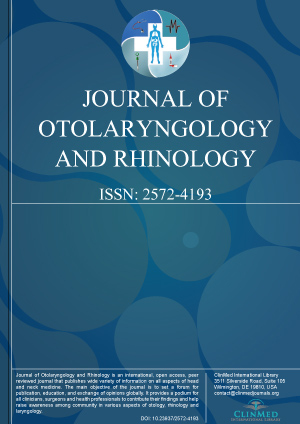Open Access DOI:10.23937/2572-4193.1510009
Eosinophilic Airway Inflammation: The Effectiveness of Nasal Steroids
Peirolo Anna, Simoncini Daniela, Macchi Alberto, Graziani Daniela, Porcu Stefania and Nespoli Luigi
Article Type: Research Article | First Published: December 24, 2015
Background: An increasing proportion of patients have coexisting upper and lower airway disease. Therefore, the historic perspective of these allergen-induced disorders as distinct and separate entities is being displaced by current thinking that they are better described as a continuum of inflammation involving one common airway. Objectives:The aim of this study was to investigate the role that upper airway inflammation and therapy plays on lower airway situation. Methods:This study was perform...
Open Access DOI:10.23937/2572-4193.1510008
Surgery Guidelines for Barrier Membranes in Guided Bone Regeneration (GBR)
Rispoli L, Fontana F, Beretta M, Poggio CE and Maiorana C
Article Type: Review Article | First Published: November 15, 2015
Objectives: To analyze the biological principles of guided bone regeneration and to provide the clinician with information regarding the use of different membranes. Materials and Methods: The choosing criteria among different membranes and the clinical options are presented. Finally, the surgical technique is described in details. Results and Conclusions: Guided bone regeneration is one of the several surgical techniques that have been introduced in the last two decades for bone regeneration pri...
Open Access DOI:10.23937/2572-4193.1510007
Nasal Glomangiopericytoma: Case Report and Clinicohistopathologic Overview
Sheldon P. Hersh and William H. Rodgers
Article Type: Case Report | First Published: September 25, 2015
Glomangiopericytoma, also known as sinonasal hemangiopericytoma, is a rare sinonasal neoplasm that commonly occurs during the sixth or seventh decade of life, often presenting with complaints of nasal congestion and epistaxis. Identified in less than 0.5% of all sinonasal tumors, this typically indolent lesion is a different tumor from the far more common and aggressive so-called soft tissue hemangiopericytoma that arises in varying sites throughout the body....
Open Access DOI:10.23937/2572-4193.1510006
A Rare Clinical Presentation of a Somewhat Common Lesion
Steve Manzon, Malcolm Zola, Jared S Weiner, Rawle F Philbert, Kevin R. Torske, Donald B MacDougall, and Daniel Nadeau
Article Type: Case Report | First Published: September 18, 2015
Clinicians are often faced with diagnosing routine oral and maxillofacial pathology. Experience and training make such tasks relatively easy. Establishing differential diagnoses, and ruling out the most unlikely, usually will lead to an appropriate treatment plan. Occasionally, a pathologic presentation may significantly differ from the expected, and stump even an experienced clinician. It is imperative, when encountering an unknown or unusual lesion, to return to basics and approach the entity ...
Open Access DOI:10.23937/2572-4193.1510003
Ramsay Hunt Syndrome Type 2: A Review of an Uncommon and Unwelcome Neurodermatologic Disease
Reid A. Waldman, Corey W. Waldman and Steven D. Waldman
Article Type: Review Article | First Published: August 28, 2015
First described in 1907 by James Ramsay Hunt, an American neurologist, Ramsay Hunt syndrome is the eponym given to a constellation of symptoms including a vesicular rash of the external ear and the ipsilateral two thirds of the tongue with associated paralysis of the seventh cranial nerve. The syndrome, which is also known as herpes zoster oticus and Hunt's syndrome, is believed to be caused by reactivation of dormant varicella-zoster virus (VZV) within the geniculate ganglion and associated sen...
Open Access DOI:10.23937/2572-4193.1510002
Suspected Aspiration of a Patency Capsule
Claude F Harbarger and Brian J Wiatrak
Article Type: Case Report | First Published: August 21, 2015
Video Capsule Endoscopy (VCE) is an established means of evaluating the upper and lower aerodigestive tracts, with 3 companies now having received FDA clearance for their devices. The most prevalent risk of VCE is capsule retention, which infrequently results in bowel obstruction. In patients suspected of having a high risk of capsule retention, a dissolvable patency capsule is given a few days prior to the VCE procedure to ensure ultimate passage of the VCE device. Here we report what is, to ou...
Open Access DOI:10.23937/2572-4193.1510001
The Subtleties and Nuances of Pediatric Sedation: A Disappearing Art for Managing the Apprehensive Child Patient
John E. Nathan
Article Type: Editorial | First Published: July 04, 2015
Pre-cooperative and severely apprehensive children have immature cognitive abilities, a restricted range of coping skills, brief or negligible attention spans, and virtually no experience coping with stress. For these children conventional communication strategies may often prove inadequate or inappropriate to overcome the behavioral manifestations of childhood dental fear and anxiety. Well- chosen pharmacological approaches has potential to permit in-office treatment, avoid aversive measures, a...

